NCERT Class 9 Maths Chapter 10 Circles Notes – Complete Summary & Formulas
A circle is a closed, geometrical figure with no corners or edges. In the circle, all the points are equidistant from the centre. A circle is a two-dimensional, round-shaped figure. There are many real-world examples of circles. Circles are used in architecture, engineering, such as civil engineering, electrical engineering, signal processing, and aerospace engineering, computer graphics, for the rotation of objects, in transportation, like the wheels of a car. Apart from this, there are many circular-shaped objects in our daily lives, such as pizza, coins, buttons, plates, and many more.
This Story also Contains
- Class 9 Chapter 9 Circles Notes PDF – Download Free Study Material
- NCERT Class 9 Maths Chapter 9 Circles: Notes
- How to Use the Circles Class 9 Notes Effectively?
- Circles Class 9 Notes: Previous Year Question and Answer
- NCERT Class 9 Maths Notes – Chapter-Wise Links
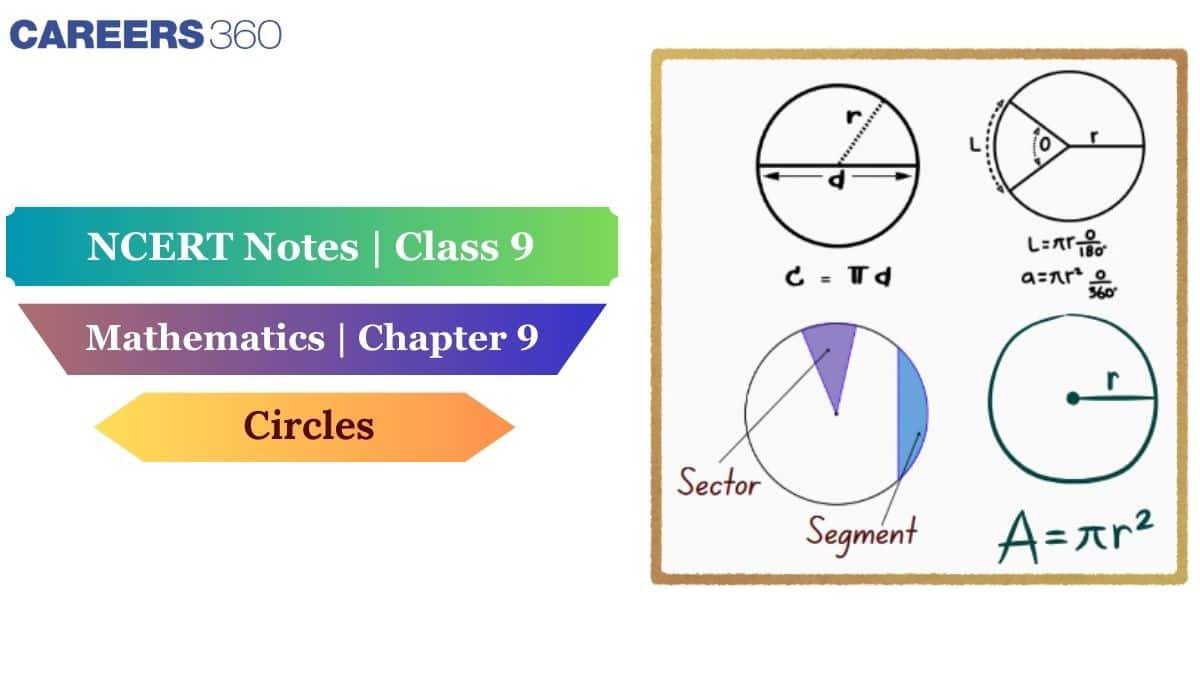
These notes cover the basic definition of circle, arc, radius, tangent and secant, chord, diameter, circumference, segment and sector and related theorems. CBSE Class 9 Chapter 10 also includes a cylindrical quadrilateral. To understand all the topics, students must go through the NCERT Class 9th Maths notes, which include all the definitions, formulas, and examples, as well as related theorems. Students can download the NCERT notes according to their subjects and standard, which our Subject Matter Experts design. Explore NCERT Books, Solutions, Syllabus, and Exemplar Problems with Solutions for complete syllabus coverage in this NCERT article.
Also, read,
Class 9 Chapter 9 Circles Notes PDF – Download Free Study Material
Careers360 brings you NCERT Class 9 Maths Chapter 9 Circles notes, carefully prepared by subject experts to simplify your studies and help in exams. A downloadable PDF is available — click the link below to access it.
NCERT Class 9 Maths Chapter 9 Circles: Notes
Circle
A circle is a two-dimensional closed geometrical figure in which all the points are equidistant from a fixed point, and this fixed point is called the centre of the circle. A circle does not have any corners or edges.
Radius
The distance from the centre of the circle to a point that lies on the surface of the circle is called the radius, and it is denoted by $r$.
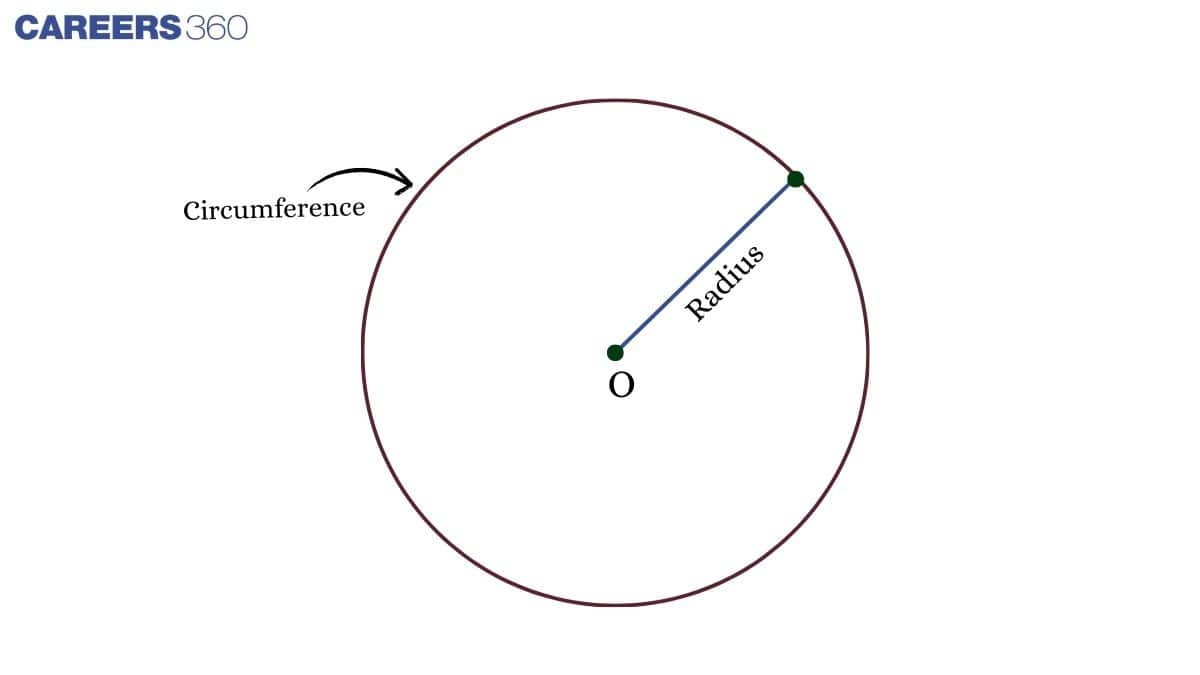
Tangent and Secant
A line that touches the surface or circumference of the circle at only one point is called the tangent of the circle. A line that cuts the surface of the circle at two points is called the secant of the circle. As shown in the figure, XY is the tangent that touches the circle at one point called Z, and AB is a secant that cuts the circle at two points called PQ.
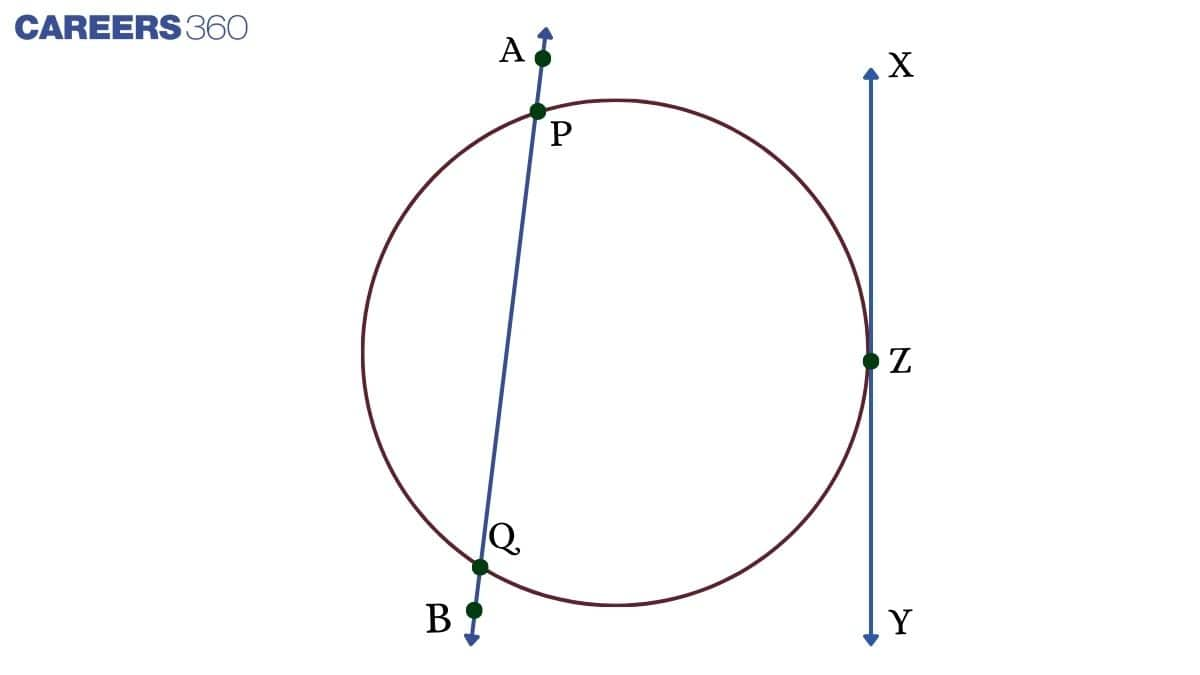
Chord
A line segment that joins two points of the circumference within the circle is called the chord of the circle.
Diameter
A chord that passes through the centre of the circle is called the diameter. The diameter is the longest chord of the circle. Diameter is twice the radius, and it is represented by $d$.
Arc
The small part or segment between the two points of the circumference of the circle is called the arc. The longer arc is called the major arc, and the smaller arc is called the minor arc.
Circumference
The distance covered around the perimeter or the surface of the circle is called the circumference of the circle. The formula for calculating the circumference of the circle is $2πr$, where $r$ is the radius of the circle.
Segment and Sector
An area of the circle that is enclosed by an arc and a chord is called the segment. The small segment of the circle is called the minor segment, and the larger segment is called the major segment.
A sector is an area of a circle that is enclosed by two radii of the circle. The small sector of the circle is called the minor sector, and the big sector of the circle is called the major sector of the circle.
Theorems for Circles and their Chord
The important theorems for circles and their chord area are as follows.
Theorem: In a circle, equal chords subtend equal angles at the centre.
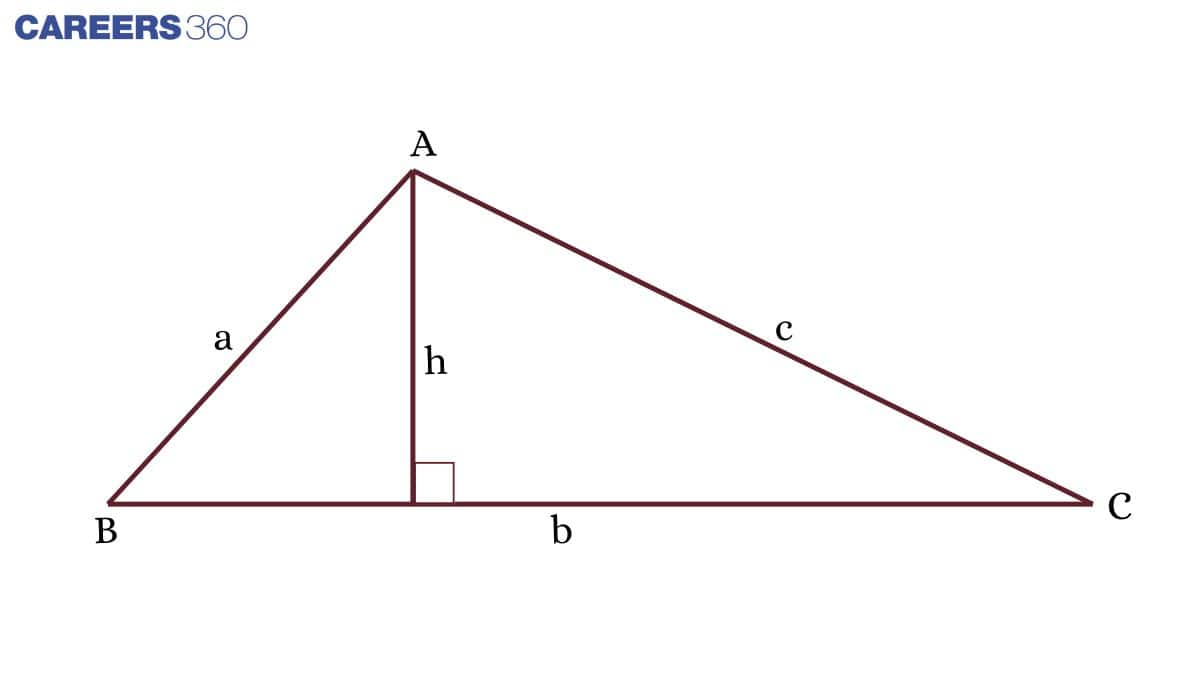
In the circle, there are two chords PQ = RS. So PQ = RS need to be proved.
In Δ POQ and ΔROS
PO = OS (Radius)
OQ = OR (Radius)
PQ = RS (Given)
ΔPOQ ≅ ΔROS (By SSS rule)
Therefore, ∠POQ = ∠ROS (Corresponding Parts of Congruent Triangles)
Theorem: The Perpendicular Line From the Centre to a Chord Bisects the Chord.
.jpg)
In the given circle, PR is a chord, and OQ is the perpendicular line drawn from the centre of the circle.
In ΔPOQ and ΔQOR,
OP = OR (Radius)
∠PQO =∠RQO (Both are right angles)
OQ = OQ (common)
Therefore, ΔPOQ ≅ ΔQOR (By RHS rule)
Hence, it is proved that PQ = QR (Corresponding Parts of Congruent Triangles)
Theorem: A Line that Passes Through the Centre and Bisects the Chord is Perpendicular to the Chord.
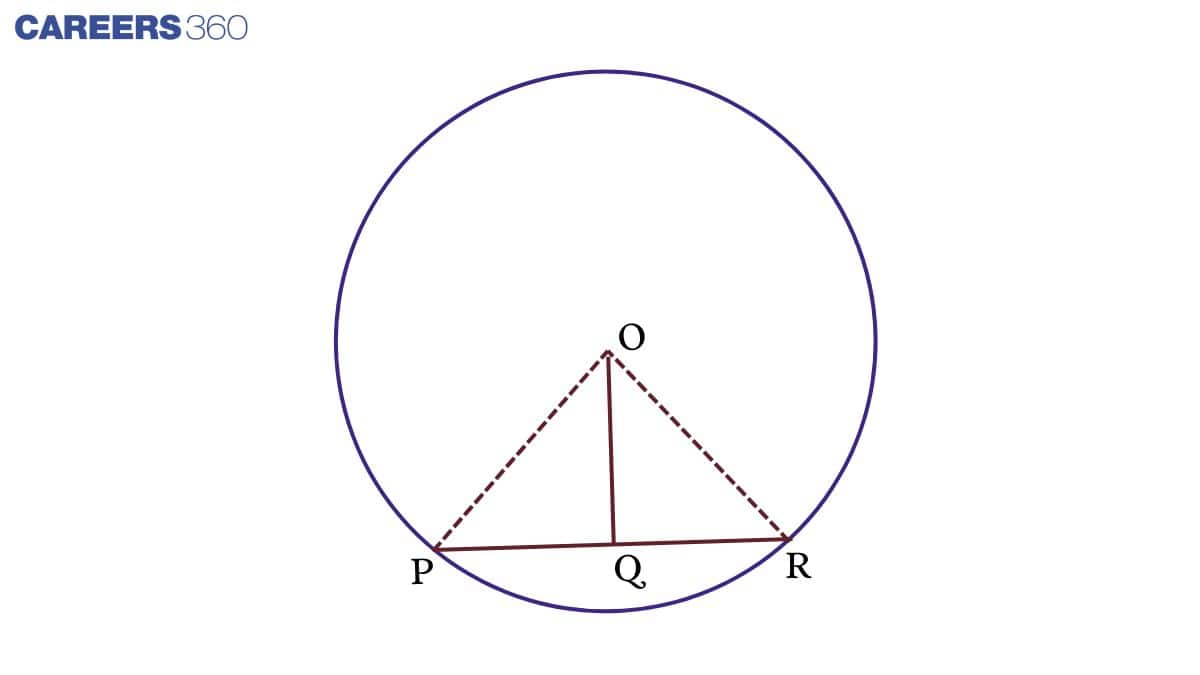
In the figure, OQ is drawn from the centre circle to bisect the chord PR. Therefore, PQ = QR.
From ΔPOQ and ΔQOR,
PQ = QR (Given)
OP = OR (Radius)
OQ = OQ (common)
Therefore, ΔPOQ ≅ ΔQOR (By SSS rule)
⇒∠OQP =∠OQR (Corresponding Parts of Congruent Triangles)
We know that ∠OQP + ∠OQR = 180° (Anles on straight line)
Therefore, ∠OQP + ∠OQR = 90°
Hence, OQ ⊥ PR
Theorem: The Distance Between Two Equal Chords From the Centre is Equal.
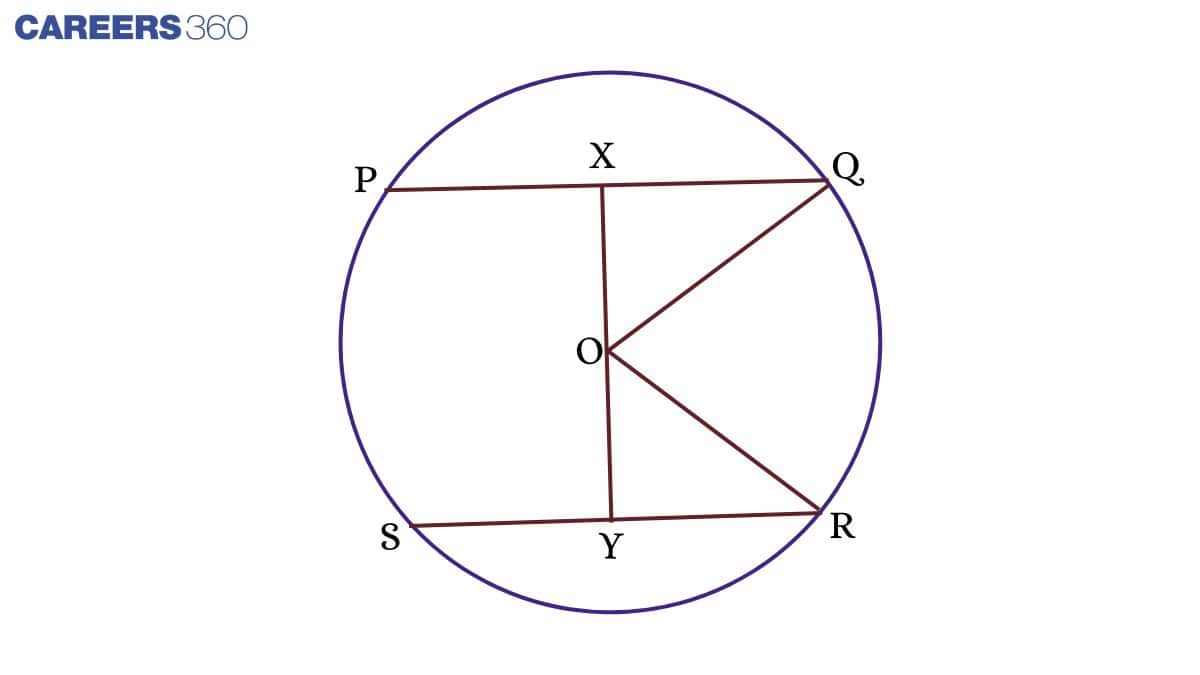
In the figure, PQ = QR, AB = CD, and O is the centre, and join OQ and OR.
Draw, OX⊥PQ, OY⊥SR
In ΔOXQ and ΔYOR,
OQ = OR (Radius)
XQ = YR (PQ = SR, and XQ and YR are the halves of PQ and SR, respectively.)
ΔOXQ ≅ ΔYOR (By RHS rule)
Therefore, OX = OY (Corresponding Parts of Congruent Triangles)
Theorem: In a Circle, Chords that are Equidistant From the Centre are Equal.
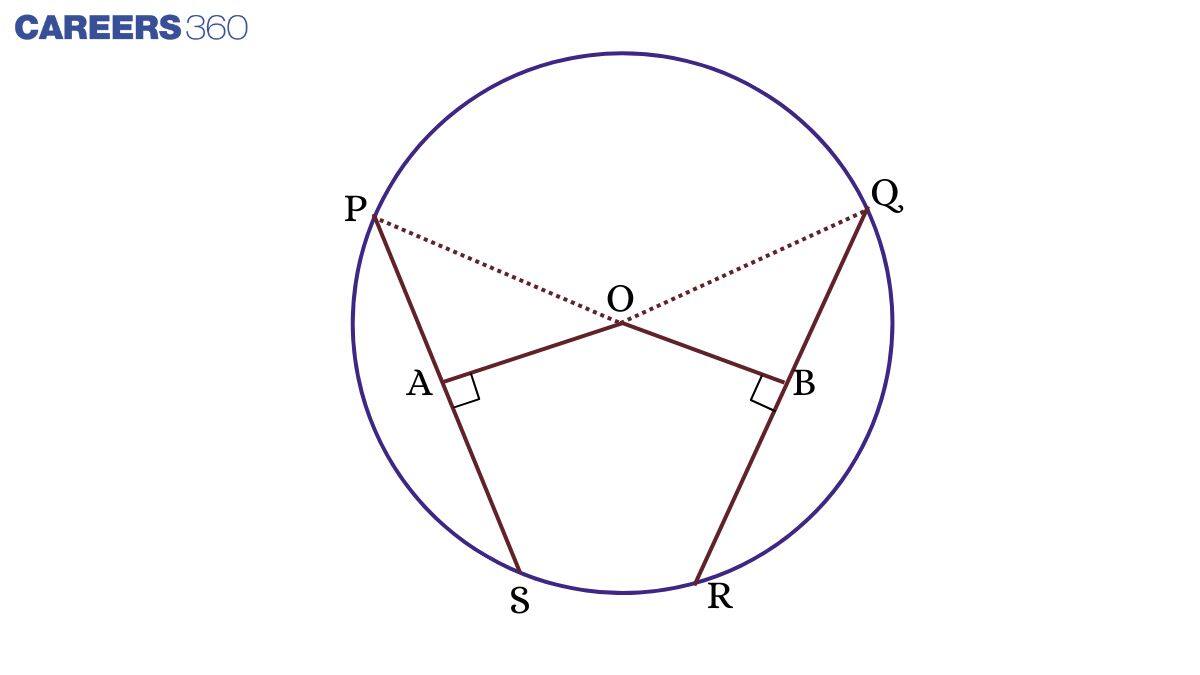
In the figure, OA = OB (Chords PS and QR are equidistant from the centre).
OA ⊥ PS, OB⊥QR
In ΔPOA and ΔQOB
∠POA =∠BOQ (Both 90°)
OP = OQ (Radius)
OA = OB (Given)
ΔPOA ≅ ΔQOB (By RHS rule)
Therefore, PA = QB (Corresponding Parts of Congruent Triangles)
Similarly, AS = BR
Hence, AB = QR
Theorem: The Angle Subtended by an Arc at the Centre is Double the Angle Subtended by it on any Part of the Circle.
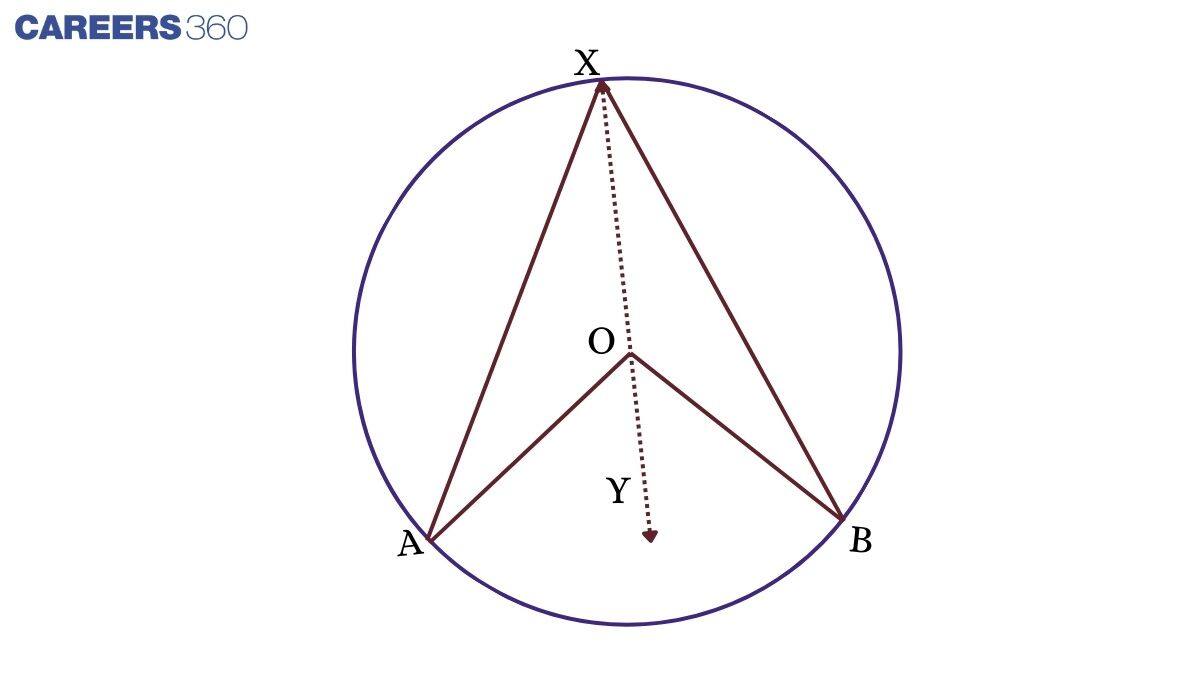
In the figure, O is the centre of the circle, and AB is an arc that subtends ∠AOB at the centre.
Combine XO and extend up to Y.
In ΔBOX,
XO = OB (Radius)
Therefore, ∠OXB = ∠OBX (Isosceles triangle)
Implies ∠YOB = 2∠OXB (Exterior angle of triangle is equal to the sum of 2 interior angles)...... (1)
Similarly,∠YOA = 2∠OXA......(2)
Add equations (1) and (2),
⇒∠YOB + ∠YOA = 2∠OXB + 2∠OXA
⇒∠AOB = 2∠AXB
Theorem: The Angles in the Same Segment of a Circle are Equal.
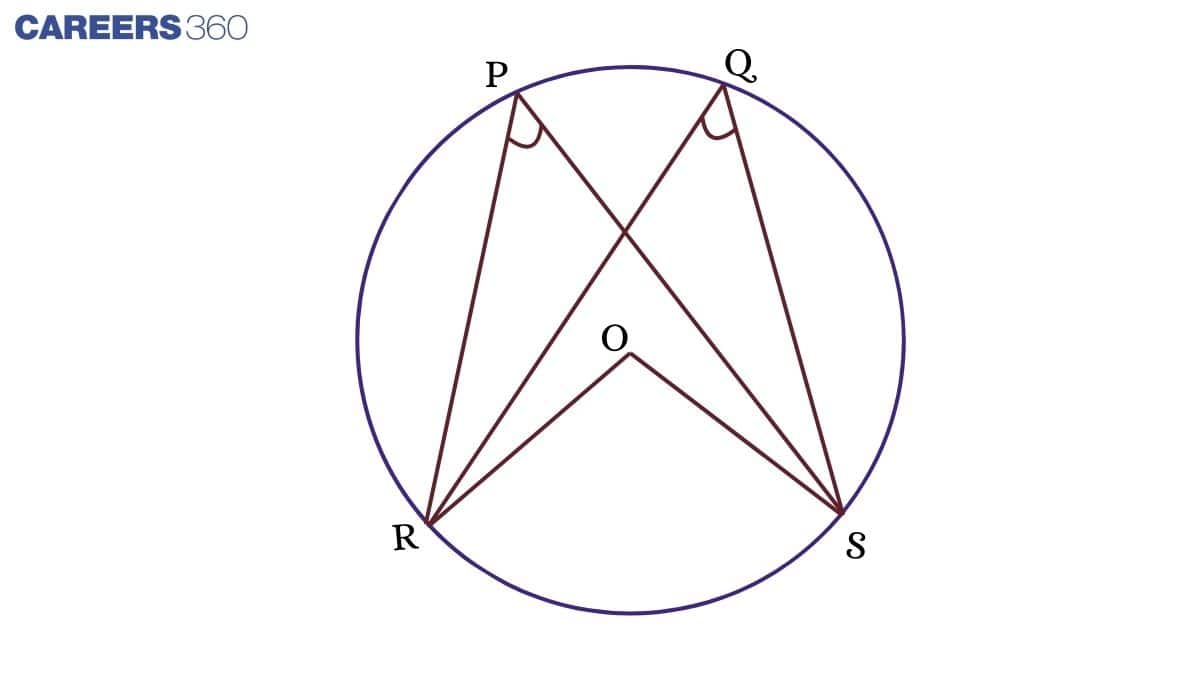
In the figure, O is the centre of the circle, and ∠RPS and ∠RQS are the angles that form the major segment.
Join RO and OS
We know that,
∠ROS = 2∠RPS = 2∠RQS (The angle subtended by an arc at the centre is double the angle subtended by it on any part of the circle)
Therefore, ∠RPS = ∠RQS
Theorem: In a Circle, the Angle Subtended by the Diameter is a Right Angle.
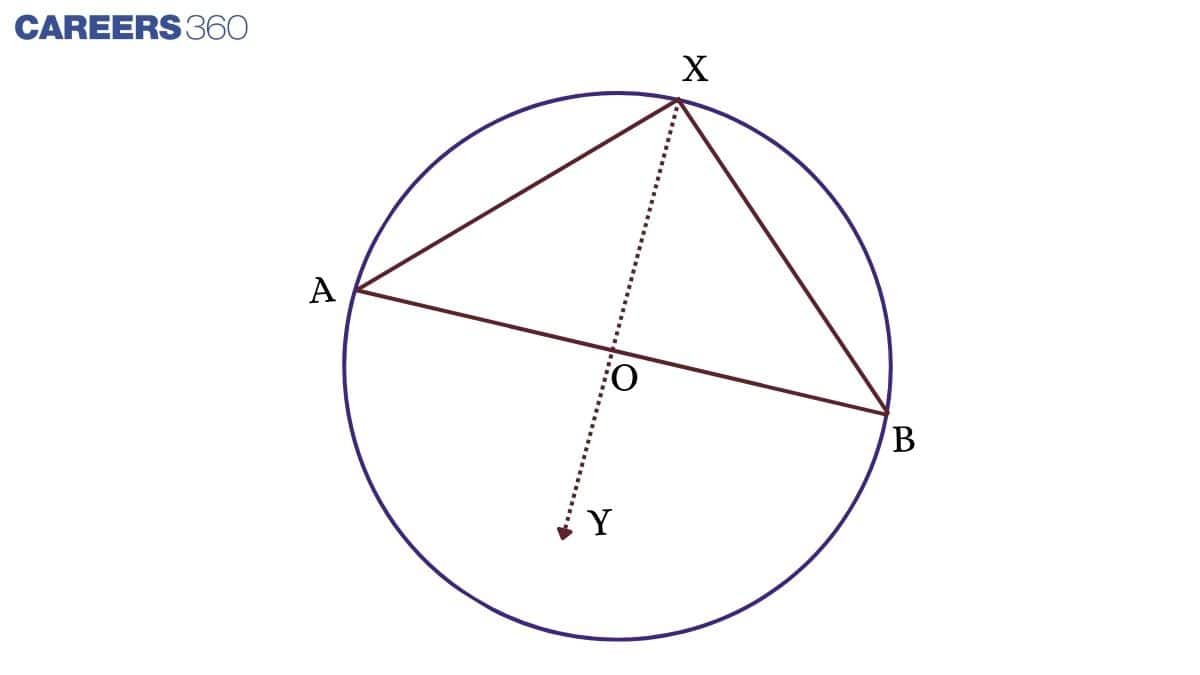
In the figure, O is the centre, and AOB is the diameter of the circle.
∠AXB is the angle for the diameter AB at the circumference.
2∠AXB = ∠AOB = 180° (Angle subtended by arc at the centre is double the angle at any other part)
∠AXB = (1/2) × 180° = 90°
Theorem: A Line Segment that Subtends Equal Angles at Two Other Points.
As shown in the figure, ∠PSQ and ∠PRQ are equal angles as PQRS is concyclic.
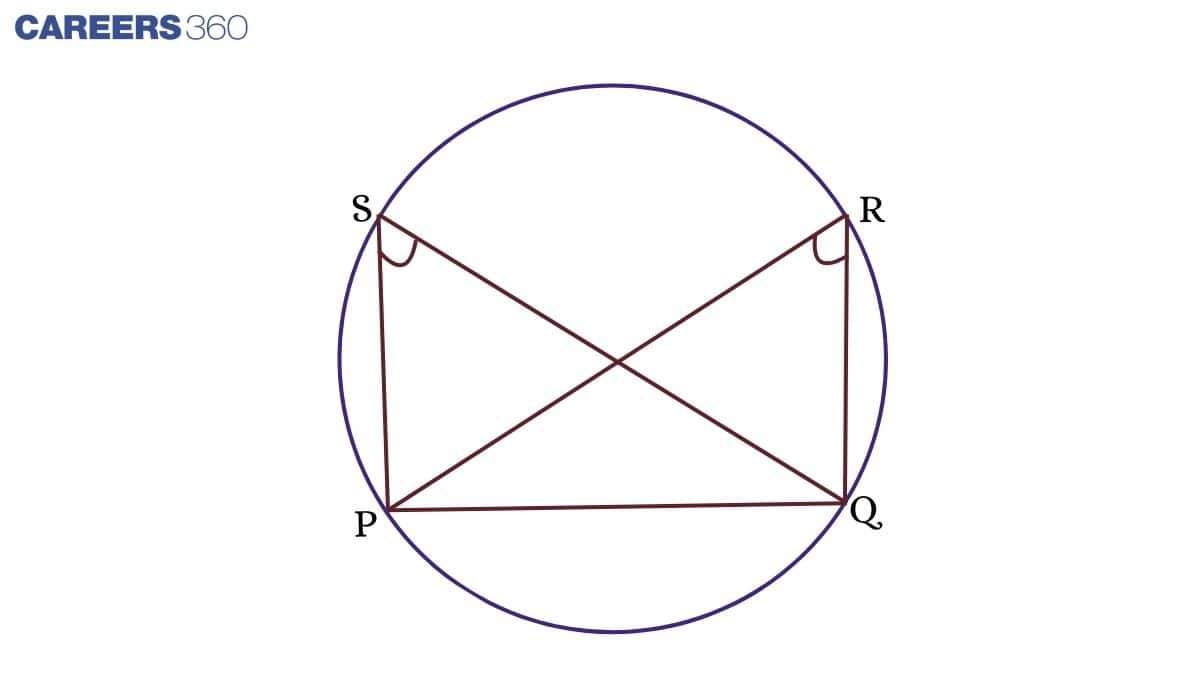
Cyclic Quadrilateral
If four vertices of a quadrilateral lie on a circle, then the quadrilateral is called a cyclic quadrilateral.
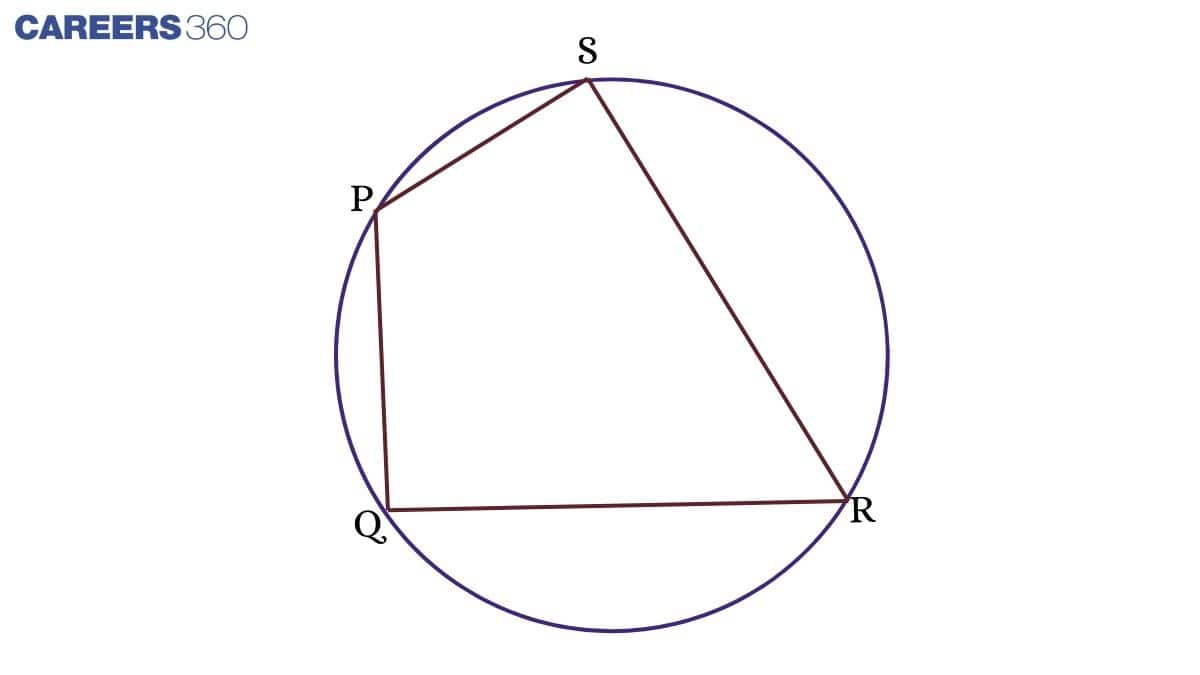
Important Properties of Cyclic Quadrilateral
1. The sum of the opposite angles of a quadrilateral is 180 degrees.
2. The sum of any pair of angles is 180 degrees.
How to Use the Circles Class 9 Notes Effectively?
Circles become easier to understand when we understand how chords, arcs, and angles are related to each other. This chapter contains many small rules, so reading them slowly with figures is helpful. When we frequently revise these ideas, solving circle questions becomes simpler. Here are some more points on how these Class 9 Maths chapter 9 notes are important.
- Read each rule about chords, angles, and arcs carefully, and draw quick sketches to understand how the angle is formed.
- Practice minor examples of perpendiculars from the centre and equal chords to keep the ideas fresh in our minds.
- Keep the NCERT Class 9 Maths chapter 9 notes beside us while solving textbook questions to check steps and understand where we go wrong.
- Use the NCERT Class 9 Maths chapter 9 notes to build a strong base, because these circle concepts help again in higher classes, especially in geometry and theorem-based questions.
Circles Class 9 Notes: Previous Year Question and Answer
Question 1:
$\mathrm{PQRS}$ is a cyclic quadrilateral. In $\mathrm{PQRS}, \angle \mathrm{P}$ is opposite to $\angle \mathrm{R}$. If $\angle \mathrm{P}$ and $\angle \mathrm{R}$ are $3 \mathrm{x}+5$ and $4 \mathrm{x}$ respectively, then what is the value of $\mathrm{x}$ ?
Solution:
Given, $\angle \mathrm{P}=3\mathrm{x}+5$ and $\angle \mathrm{R}=4\mathrm{x}$
Since $\angle \mathrm{P}$ and $\angle \mathrm{R}$ are opposite to each other in a cyclic quadrilateral, we have $\angle \mathrm{P}+\angle \mathrm{R}=180^\circ$
⇒ $3\mathrm{x}+5+4\mathrm{x}=180^\circ$
⇒ $\mathrm{x}=25^\circ$
Hence, the correct answer is 25 degrees.
Question 2:
The sum of the angles made by a chord XY at the centre and on the circumference of the circle is 270°. If the radius of this circle is 24 cm, then what will be the length of this chord?
Solution:
Given, the radius of the circle = 24 cm
Let the angle formed by the chord on the circumference be x.
Then, the angle formed by the same chord on the centre is 2x.
According to the question,
2x + x = 270°
⇒ x = 90°
It means the chord is the diameter, as the diameter makes a 90° angle on the circumference.
Length of this chord = diameter = 2 × 24 = 48
Hence, the correct answer is 48 cm.
Question 3:
The distance of a chord JK from the centre is 7 cm. If the diameter of this circle is 50 cm, then what will be the length of this chord?
Solution:
The radius of the circle is half the diameter.
The radius = $\frac{50}{2}$ = 25 cm
Let the length of the chord JK = $2x$ cm
The distance from the centre of the circle to the chord = 7 cm
The perpendicular from the centre of a circle to a chord bisects the chord,
So, JP = $x$ cm
Applying the Pythagorean theorem, we get:
$⇒x = \sqrt{r^2 - d^2} = \sqrt{25^2 - 7^2} = \sqrt{576} = 24$
The length of the chord (in cm) JK $= 2x = 2 \times 24 = 48\ \text{cm}$
Hence, the correct answer is 48 cm.
NCERT Class 9 Maths Notes – Chapter-Wise Links
We at Careers360 compiled all the NCERT class 9 Maths notes in one place for easy student reference. The following links will allow you to access them.
NCERT Solutions for Class 9
Students must check the NCERT solutions for Class 9 Maths and Science given below:
NCERT Exemplar Solutions for Class 9
Students must check the NCERT exemplar solutions for Class 9 Maths and Science given below:
NCERT Books and Syllabus
To learn about the NCERT books and syllabus, read the following articles and get a direct link to download them.
Courses After 12th
Applications for Admissions are open.
As per latest syllabus. Physics formulas, equations, & laws of class 11 & 12th chapters
JEE Main Important Chemistry formulas
Get nowAs per latest syllabus. Chemistry formulas, equations, & laws of class 11 & 12th chapters
JEE Main high scoring chapters and topics
Get nowAs per latest 2024 syllabus. Study 40% syllabus and score upto 100% marks in JEE
JEE Main Important Mathematics Formulas
Get nowAs per latest syllabus. Maths formulas, equations, & theorems of class 11 & 12th chapters


